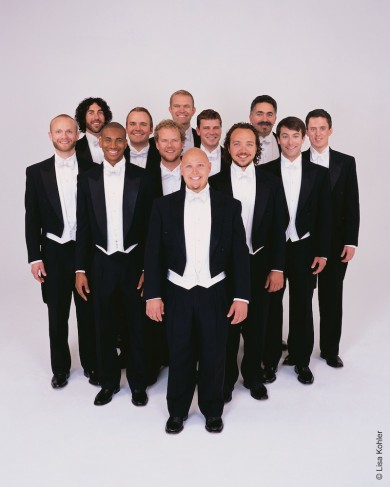Chanticleer’s Florida program showcases their eclectic style and distinctive sound

Chanticleer performed Wednesday night at the Parker Playhouse in Fort Lauderdale.
For three decades Chanticleer has traversed the a capella choral repertoire, singing everything from Renaissance and Baroque motets to the latest pop standards. The male vocal ensemble has also commissioned a large body of new choral literature as well as regularly programming contemporary scores.
The 14-member group’s generous program presented Wednesday night in Fort Lauderdale drew a large audience, evidence of this iconic ensemble’s enduring popularity.
One of the striking characteristics of this ‘orchestra of voices” is the lack of vocal homogeneity among its members. Individual sopranos, altos, tenors and lower voices have divergent timbres and vocal personalities; yet the group’s suave, resonant tone and precise musicianship produce a distinctive sound. Under the interim musical direction of Jace Wittig, Chanticleer continues to presents adventurous programs, spotlighting rarely heard works from the byways of the choral literature.
It took about twenty minutes for the group to adapt to the dull acoustics of the Parker Playhouse Wednesday, but they eventually emphasized dynamic contrasts and musical exclamations so as to be more clearly heard.
The opening Renaissance motets by Sebastian de Vivanco and Tomas Luis de Victoria combined antiphonal polyphony with vibrant dance, mixing sacred and secular musical styles. Maurice Durufle’s Ubi caritas melds the simplicity of Gregorian chant with sensuous harmonies and complex vocal lines. This score captured the smooth and mellow sound that has become the ensemble’s signature. The singers divided into quartets for three Renaissance madrigals, capturing the simple charm of these French chansons.
Richard Strauss’ early Drei Mannerchore was written for all-male amateur singing societies in late 19th century Germany. While “Von dei Turen” (At the Gates) was a ponderous rumination on death, “Traumlicht” (Dreamlight) sang in lyric tones and “Frohlich im Maien” (Joyous in May) recalled the rousing joy of a Germanic drinking song.
For all the charms of these rarely heard pieces, the contemporary repertoire displayed Chanticleer at its best. Not the End of Loving is a three-song cycle by Lehigh University Choral Union director Steven Sametz, commissioned for Chanticleer in 2010. “Where I Become You” is a spirited round while “We Two Boys Clinging Together,” set to a text by Walt Whitman, backs a homoerotic duet for tenor and baritone with rollicking choral rhythm. “Not an End of Loving” is a solemn but hopeful farewell to life. Sametz’s melodic gift and creative mastery shines through this expertly crafted score.
The superficial, pop inflected choral works of Eric Whitacre lack the ingenuity of the best Hollywood soundtracks. His deftly commercial pieces go down easy and are just as easily forgotten. This Marriage was a good example of Whitacre’s brand of choral elevator music. By contrast, Sir John Tavener’s A Village Wedding brings the austere musical liturgy of the Russian Orthodox Church up to date with astringent twists of phrase and tone.
Four excerpts from The Lotus Lovers by Stephen Paulus are imbued with the composer’s edgy lyricism, encompassing sudden leaps between registers and constant changes of meter. Based on Chinese poetry, the songs are touching and beautiful and displayed the singers’ superbly disciplined control of dynamics and pitch.
Songs by Duke Ellington and Freddie Mercury, in the wildly imaginative settings of John Gordon and Vince Peterson, concluded a well chosen program, artfully presented.